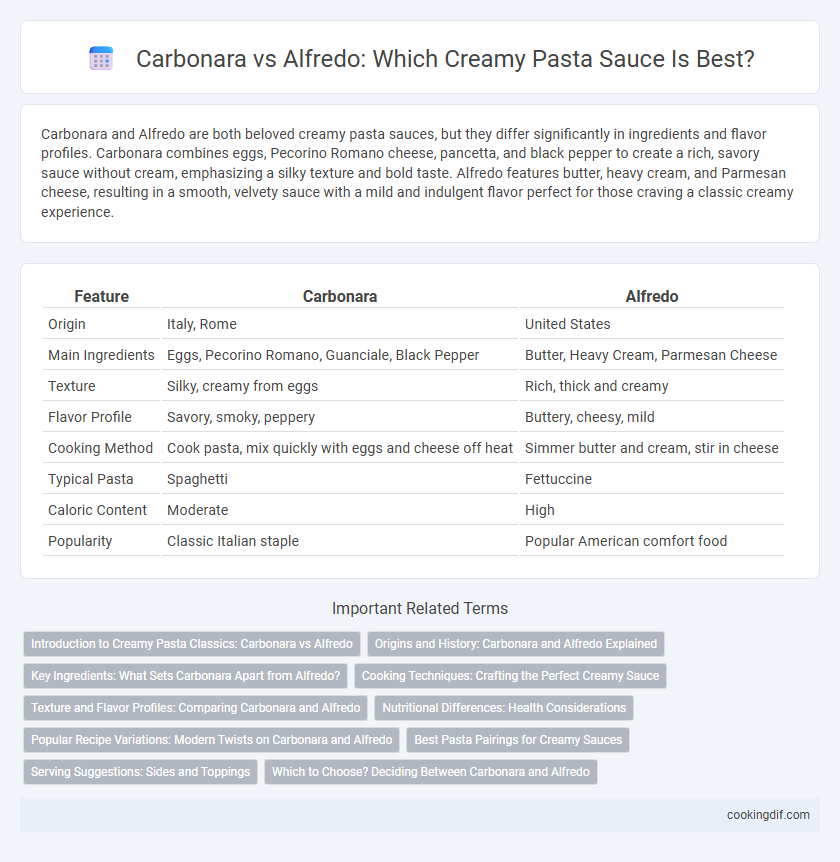Carbonara and Alfredo are both beloved creamy pasta sauces, but they differ significantly in ingredients and flavor profiles. Carbonara combines eggs, Pecorino Romano cheese, pancetta, and black pepper to create a rich, savory sauce without cream, emphasizing a silky texture and bold taste. Alfredo features butter, heavy cream, and Parmesan cheese, resulting in a smooth, velvety sauce with a mild and indulgent flavor perfect for those craving a classic creamy experience.
Table of Comparison
| Feature | Carbonara | Alfredo |
|---|---|---|
| Origin | Italy, Rome | United States |
| Main Ingredients | Eggs, Pecorino Romano, Guanciale, Black Pepper | Butter, Heavy Cream, Parmesan Cheese |
| Texture | Silky, creamy from eggs | Rich, thick and creamy |
| Flavor Profile | Savory, smoky, peppery | Buttery, cheesy, mild |
| Cooking Method | Cook pasta, mix quickly with eggs and cheese off heat | Simmer butter and cream, stir in cheese |
| Typical Pasta | Spaghetti | Fettuccine |
| Caloric Content | Moderate | High |
| Popularity | Classic Italian staple | Popular American comfort food |
Introduction to Creamy Pasta Classics: Carbonara vs Alfredo
Carbonara and Alfredo stand out as iconic creamy pasta sauces with distinct origins and flavor profiles, originating from Italy and Italian-American cuisine, respectively. Carbonara combines eggs, Pecorino Romano cheese, guanciale, and black pepper to create a rich, silky texture without cream, while Alfredo relies on butter, heavy cream, and Parmesan cheese for a smooth, indulgent consistency. These sauces highlight contrasting techniques in achieving creaminess, with Carbonara emphasizing emulsification and Alfredo focusing on dairy-based richness.
Origins and History: Carbonara and Alfredo Explained
Carbonara, originating from Rome during World War II, is a traditional Italian pasta sauce made with eggs, Pecorino Romano cheese, guanciale, and black pepper, showcasing a rich yet simple flavor profile. Alfredo sauce, created by Alfredo Di Lelio in early 20th-century Rome, combines butter and Parmesan cheese to produce a creamy, dairy-forward texture that gained widespread popularity in the United States. Both sauces highlight Italian culinary creativity, with carbonara emphasizing savory, egg-thickened sauce and Alfredo focusing on buttery, cheesy creaminess.
Key Ingredients: What Sets Carbonara Apart from Alfredo?
Carbonara distinguishes itself with key ingredients like eggs, Pecorino Romano cheese, guanciale, and black pepper, creating a rich yet savory sauce without cream. Alfredo sauce, in contrast, relies primarily on heavy cream, butter, and Parmesan cheese for its smooth, creamy texture. The use of eggs and cured pork in carbonara results in a bolder, more complex flavor profile compared to Alfredo's milky and buttery richness.
Cooking Techniques: Crafting the Perfect Creamy Sauce
Carbonara achieves its creamy texture through the emulsification of eggs, cheese (Pecorino Romano or Parmesan), and rendered pork fat, requiring careful tempering to avoid scrambling. Alfredo sauce relies on gently melting butter and mixing it with heavy cream and Parmesan cheese, emphasizing constant low heat to create a smooth, rich consistency. Mastering carbonara demands precision timing and heat control, while Alfredo offers a more straightforward technique, both yielding distinctively luscious creamy sauces.
Texture and Flavor Profiles: Comparing Carbonara and Alfredo
Carbonara features a rich, silky texture achieved through the emulsification of eggs and cheese, creating a creamy sauce with a slightly grainy mouthfeel and a savory, smoky flavor from pancetta or guanciale. Alfredo offers a smoother, velvety consistency with its heavy cream and butter base, delivering a rich, buttery flavor that is milder and less complex than carbonara. The contrast in texture and flavor makes carbonara more robust and textured, while Alfredo emphasizes creamy smoothness and subtle richness.
Nutritional Differences: Health Considerations
Carbonara typically contains eggs, pancetta, pecorino Romano cheese, and black pepper, offering higher protein and fat content but lower in carbohydrates compared to Alfredo, which relies on heavy cream, butter, and Parmesan cheese, leading to increased saturated fat and calorie levels. Alfredo sauces tend to be richer in calories and saturated fats, presenting higher cholesterol risks, whereas carbonara's egg-based sauce provides essential nutrients like choline and vitamin D. For health-conscious individuals, carbonara may offer a slightly better nutritional profile due to less reliance on heavy cream, but portion control remains key to managing calorie and fat intake in both dishes.
Popular Recipe Variations: Modern Twists on Carbonara and Alfredo
Modern twists on carbonara incorporate ingredients like peas, mushrooms, or smoked salmon to enhance the creamy texture while maintaining the traditional egg and cheese base. Alfredo variations often substitute heavy cream with Greek yogurt or cashew cream, creating a lighter yet rich sauce without compromising flavor. Both sauces see frequent innovation in contemporary recipe adaptations, blending classic Italian techniques with diverse global flavors.
Best Pasta Pairings for Creamy Sauces
Carbonara, traditionally made with eggs, Pecorino Romano, pancetta, and black pepper, pairs exceptionally well with spaghetti or bucatini, allowing the creamy yet savory sauce to cling to the strands. Alfredo sauce, rich with butter, heavy cream, and Parmesan cheese, complements fettuccine or tagliatelle, whose broad, flat surfaces hold the thick, luscious sauce perfectly. For the best pasta pairings with creamy sauces, selecting shapes like long hollow strands for carbonara and wide ribbons for Alfredo maximizes flavor absorption and texture contrast.
Serving Suggestions: Sides and Toppings
Carbonara pairs well with simple sides like garlic bread or a fresh arugula salad to balance its smoky pancetta and creamy egg-based sauce. Alfredo complements dishes with steamed broccoli or sauteed mushrooms, enhancing its rich, buttery Parmesan flavor. Both sauces benefit from a sprinkle of freshly ground black pepper and grated cheese to elevate the overall taste experience.
Which to Choose? Deciding Between Carbonara and Alfredo
Carbonara delivers a rich, creamy texture using eggs, Pecorino Romano cheese, pancetta, and black pepper, creating a savory and slightly smoky flavor profile. Alfredo sauce combines heavy cream, butter, and Parmesan cheese for a smoother, buttery, and milder taste that complements a variety of pasta shapes. Choosing between carbonara and Alfredo depends on whether you prefer a bold, traditional Roman dish or a rich, comforting Italian-American classic.
carbonara vs alfredo for creamy sauces Infographic

 cookingdif.com
cookingdif.com